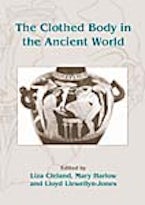The recent renaissance of interest in the history of dress and its cultural importance is celebrated in this collection of interdisciplinary essays. The sixteen contributors present on-going research into the study of the clothed body in ancient Egypt and the Aegean, Classical Greece, Rome and Late Antiquity. Through literary and artistic evidence and film, they discuss how dress articulates and defines an individual within his or her given society, at the same time highlighting common themes in scholarship, methodological differences between disciplines and periods, as well as contrasting definitions of what constitutes the clothed body. Essays discussing Aegean Bronze Age fashions, costume design in filmed biblical epics, clothing in Aristophanic comedy, Greek and Roman female undergarments, the symbolism of the Roman toga, and the spectacle of images of Byzantine dress, are just some of the diverse subjects covered in this study.
Introduction: 'I wear this therefore I am': The clothed body in the ancient world (Mary Harlow, Lloyd Llewellyn-Jones and Liza Cleland); The Clothed Body in Egypt and the Aegean The decorated body in ancient Egypt: Hairstyles, cosmetics and tattoos (Joann Fletcher); The fashioning of Delila:. Costume design, historicism and fantasy in Cecil B. DeMille's Samson and Delilah (1949) (Lloyd Llewellyn-Jones); Reconstructing Aegean Bronze Age fashions (Ariane Marcar); Trailing tunics and sheepskin coats: Dress and status in early Greece (Hans von Wees); The Clothed Body in Classical Greece Constu(ct)ing gender in the feminine Greek peplos (Mirielle Lee); New clothes, a new you: Clothing and character in Aristophanes (James Robson); Beauty in rags: On rhakos in Aristophanic theatre (Silvia Milanezi); The semiosis of description: Some reflections on fabric and colour in the Brauron Inventories (Liza Cleland); Viewing and obscuring the female breast: Glimpses of the ancient bra (Emma J Stafford); The Clothed Body in Rome and Late Antiquity The toga praetexta of Roman children and praetextate garments (Judith Sebesta); What made the Roman toga virilis? (Glenys Davies); Men are Mars, women are Venus: Divine costumes in Imperial Rome (Shelley Hales); Dress in the Historia Augusta: The role of dress in historical narrative (Mary Harlow); Get your kit on! Some issues in the depiction of clothing in Byzantium (Liz James and Shaun Tougher); Tunics from Kasr al-Yahud (Orit Shamir); Bibliography.

